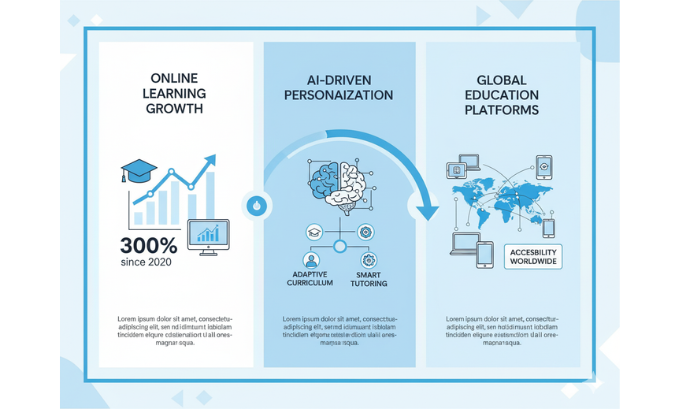The world of education is undergoing a seismic shift, and technology is the driving force. For educators and professionals seeking new horizons, this transformation has unlocked a wealth of opportunities in the burgeoning field of Educational Technology (EdTech). If you’re a teacher wondering what’s next or a professional passionate about learning, exploring education technology jobs could be your most rewarding career move yet.
The COVID-19 pandemic acted as an unprecedented catalyst, forcing schools and businesses worldwide to adopt digital learning solutions overnight. This rapid transition highlighted the critical need for skilled professionals who can bridge the gap between education and technology. The demand for experts in instructional design and digital learning has since soared, creating a stable and rewarding career path. For those looking to dive deeper into EdTech, exploring distance learning resources and the latest in education technology news today can provide a solid foundation.
This guide provides a comprehensive roadmap to the world of education technology jobs. We’ll cover the most in-demand roles, the skills you need to succeed, typical salary expectations, and how you can transition into this exciting field. Whether you’re considering a Learning Design and Technology Master’s Degree or want to leverage your existing skills, this article will show you what a future in EdTech can look like.
Table of Contents
What is Educational Technology?

Educational Technology (EdTech) is a field dedicated to improving learning and performance by creating, using, and managing appropriate technological processes and resources. It’s not just about putting laptops in classrooms; it’s a systematic approach to designing effective and engaging learning experiences. From K-12 classrooms using interactive tools like Blooket and Quizlet to corporations deploying complex learning management systems, EdTech is everywhere. The field has seen explosive growth, a trend confirmed by ongoing education technology news today.
The core goal of EdTech is to enhance education. This could mean making learning more accessible for students with disabilities, personalizing instruction to individual needs, or using data to understand how students learn best. Professionals in this field are part instructional designers, part project managers, and part tech evangelists, all working to make learning more impactful. To get a better sense of how technology integrates into various learning models, understanding the STEM education meaning provides valuable context.
Why is the EdTech Field Growing So Rapidly?
The demand for education technology jobs has surged for several key reasons, with the COVID-19 pandemic being a major accelerator. When schools and businesses shifted to remote work and learning, the need for robust digital education solutions became undeniable. This created an immediate demand for professionals who could design and implement effective online learning programs.

Beyond the pandemic’s impact, several other factors are fueling the growth:
- The Rise of Lifelong Learning: Professionals in every industry need to constantly update their skills. Companies are investing heavily in corporate training and development, creating a huge market for EdTech solutions. Exploring resources on how to work with artificial intelligence is a prime example of this trend.
- Personalization at Scale: AI and data analytics allow for personalized learning paths that cater to individual student needs and paces, a significant improvement over one-size-fits-all models. The latest AI in social media marketing strategies show how personalization is transforming various sectors.
- Globalization of Education: Digital platforms make it possible for students to access courses and degree programs from institutions around the world, such as the best universities in Japan.
- Focus on Skill-Based Training: There’s a growing emphasis on practical, job-ready skills. EdTech platforms, especially those offering best coding courses, are perfectly suited to deliver this type of training efficiently.
This sustained growth means that a career in EdTech offers not just opportunity but also long-term job security.
My Transition from Classroom Teacher to EdTech Leader
As a former high school English teacher, I remember the days of overhead projectors and paper-based assignments. When my district started rolling out Google Apps for Education, I was both excited and intimidated. I dove headfirst into learning everything I could about Google Docs, Google Drive, and the suite of tools that promised to transform my classroom.
My “aha!” moment came during a research paper unit. Instead of collecting paper drafts covered in red ink, I had students share their Google Docs with me. I could leave comments in real-time, link to resources directly in the document, and watch their writing evolve. More importantly, they could collaborate with each other, peer-editing in a way that was never possible before. Student engagement skyrocketed. I wasn’t just teaching English anymore; I was facilitating learning in a dynamic, tech-infused environment.
This experience ignited a new passion. I started leading professional development sessions for other teachers, showing them how to integrate these tools. I eventually pursued a Learning Design and Technology Master’s Degree, which opened doors I never knew existed. Today, as an Instructional Design consultant, I help organizations build entire learning ecosystems. The challenges are different, but the core mission is the same: using technology to create meaningful learning experiences. My journey is a testament to the fact that the skills you have as an educator are the perfect foundation for a successful career in EdTech.
What I Like / Strengths of an EdTech Career
- High Impact: You have the ability to influence learning for thousands, or even millions, of people.
- Constant Innovation: The field is always changing, with new tools and theories to explore. It’s a career that never gets boring.
- Diverse Opportunities: You can work in K-12, higher education, corporate training, non-profits, or even the military.
- Strong Earning Potential: EdTech roles often come with a significant salary increase compared to traditional teaching positions.
- Flexibility: Many education technology jobs offer remote or hybrid work options, providing a better work-life balance.
Areas for Improvement and Challenges
- Keeping Pace with Technology: The rapid evolution of tech means you must be a lifelong learner. What’s cutting-edge today, like the latest on the Apple iPhone 17 Pro Max, might be standard tomorrow.
- Resource Inequality: Access to technology is not equal across all schools and organizations, which can be a frustrating barrier. Finding sufficient distance learning resources is a constant challenge.
- Proving ROI: In a corporate setting, you often need to demonstrate the financial impact of your training programs.
- Navigating Bureaucracy: Working within large educational or corporate systems can sometimes be slow and challenging.
Top Industries for Education Technology Jobs
EdTech is not a monolith. The skills of an instructional designer or educational technologist are in demand across a wide range of sectors. Understanding these top EdTech industries can help you focus your job search.
| Industry | Description | Why EdTech is Crucial |
|---|---|---|
| K-12 & Higher Education | The traditional heart of EdTech, encompassing schools, colleges, and universities. | To improve student outcomes, facilitate remote learning, and manage educational resources. Institutions like Tech Mahindra University are examples of modern, tech-forward education. |
| Corporate/Business | Includes employee training, onboarding, compliance, and leadership development in companies of all sizes. | For efficient and scalable employee development, ensuring a skilled workforce and reducing training costs. |
| Healthcare | Training for medical professionals, patient education, and compliance with healthcare regulations. | To keep medical staff updated on the latest procedures and technologies and to educate patients about their health. |
| Government & Military | Development of training programs for government employees and military personnel. | For large-scale, standardized training on complex procedures, security protocols, and operational readiness. |
| Non-profits | Creating educational materials and training programs for volunteers, staff, and the communities they serve. | To efficiently train a distributed workforce and deliver their mission-driven educational content to a wider audience. |
| Tech Companies | EdTech startups and established tech giants creating the next generation of learning tools and platforms. | This is the engine of the industry, developing products from AI for brand strategy to platforms for the Consumer Electronics Show 2025. |
In-Demand EdTech Job Titles and Salaries
The field of EdTech offers a variety of roles, each with its own focus and responsibilities. Here’s a look at some of the most common EdTech job titles and their typical salary ranges, with data informed by the U.S. Department of Labor, Employment & Training Administration (O*NET Online).

Top Educational Technology Job Titles
- Instructional Designer: This is one of the most common roles. Instructional designers create learning experiences. They work with subject matter experts (SMEs) to define learning objectives, design content, and develop instructional materials.
- Curriculum Designer/Developer: Similar to an instructional designer, but often with a broader focus on creating an entire curriculum or program of study. They ensure content is sequenced logically and aligns with standards like those from the International Society for Technology in Education (ISTE).
- Learning Experience (LX) Designer: This role takes a user-experience (UX) approach to instructional design, focusing on creating learning that is not just effective but also engaging, intuitive, and enjoyable for the learner.
- Educational Technologist: These professionals often work within a school or district to support teachers in integrating technology. They might provide training, troubleshoot issues, and research new tools.
- Technology Integration Specialist: A hands-on role focused on helping teachers effectively use specific technologies, from interactive whiteboards to learning platforms like Kahoot and Canva.
- Digital Learning Designer: This title emphasizes the creation of digital content, such as e-learning modules, videos, and interactive simulations.
Salary Expectations
Salaries for education technology jobs can vary widely based on industry, location, experience, and education level. However, they generally offer a significant increase over a typical teacher’s salary.
- Entry-Level (0-3 years experience): $60,000 – $80,000
- Mid-Career (4-8 years experience): $80,000 – $110,000
- Senior/Lead Level (8+ years experience): $110,000 – $150,000+
Roles in the corporate sector, especially in tech and finance, tend to be on the higher end of these ranges. For those looking to maximize their earning potential, exploring opportunities in high-growth areas like cybersecurity trends for 2025 within a training context can be lucrative.
Paving Your Path to an EdTech Career
Transitioning into an education technology job is a journey that requires strategic planning.

1. Leverage Your Existing Skills
If you’re a teacher, you already have a strong foundation in pedagogy, classroom management, and understanding learners’ needs. These are highly transferable skills. Start by becoming the “go-to” tech person at your school. Volunteer to lead a workshop or pilot a new tool. This builds experience and demonstrates your initiative.
2. Master the Top Educational Technologies
Familiarity with the tools of the trade is non-negotiable. Gain proficiency in a variety of top educational technologies:
- Learning Management Systems (LMS): Canvas, Blackboard, Moodle, Google Classroom.
- Authoring Tools: Articulate 360 (Storyline and Rise), Adobe Captivate.
- Engagement Platforms: Kahoot, Quizlet, BrainPOP, and Blooket host functionalities.
- Design Tools: Canva, Vyond, Camtasia.
- Collaboration Suites: Google Apps for Education, Microsoft 365.
3. Consider Advanced Education
While not always required, a master’s degree can significantly accelerate your career. A Learning Design and Technology Master’s Degree provides a deep dive into learning theories, instructional design models (like ADDIE and SAM), and project management. It also offers networking opportunities and credibility that can open doors to leadership roles. When researching programs, consider factors like the cost of studying in Japan versus domestic options if you’re looking for international experience.
4. Build a Portfolio
A portfolio is your most important asset when job hunting. It’s a collection of projects that showcases your skills. If you don’t have professional projects yet, create your own. For example:
- Redesign a poor training module you’ve experienced.
- Create a short e-learning module on a topic you’re passionate about.
- Develop a job aid or a video tutorial.
Host your portfolio on a personal website to make it easily accessible to potential employers. A strong digital presence is key, and understanding aspects of digital marketing can be surprisingly beneficial.
Frequently Asked Questions (FAQ)
1. Do I need a master’s degree to get an education technology job?
Not always, but it helps immensely. A Learning Design and Technology Master’s Degree can make you a more competitive candidate, especially for higher-level roles. Many professionals successfully transition with certificates and a strong portfolio.
2. What is the most important skill for an instructional designer?
Empathy. You must be able to put yourself in the learner’s shoes to understand their needs, motivations, and challenges. Technical skills can be taught, but a learner-centric mindset is essential.
3. Can I get an EdTech job if I’m not a teacher?
Absolutely. Professionals from fields like graphic design, project management, and writing often find great success in EdTech. The key is to connect your existing skills to the needs of the role and show a passion for learning.
4. What are some of the top EdTech tools I should learn?
Start with Articulate 360 (especially Rise and Storyline), as it’s the industry standard for creating e-learning. Also, become proficient with a major LMS like Canvas and a design tool like Canva.
5. How can I gain experience if I don’t have an EdTech job yet?
Volunteer! Offer to help a local non-profit create a training module. Create personal projects for your portfolio. Join professional organizations like the Association for Talent Development (ATD) to network and find opportunities.
6. Are EdTech jobs remote-friendly?
Yes, very. The nature of the work is digital, and the COVID-19 pandemic solidified remote work as a standard option for many EdTech roles, a trend you can follow through sites that cover education technology news today.
7. What is the difference between instructional design and curriculum design?
Instructional design often focuses on a specific learning experience, like a single course or module. Curriculum design takes a broader view, planning an entire program of study and how different courses fit together. The roles often overlap.
Your Next Chapter Starts Now
The field of educational technology offers a dynamic, impactful, and financially rewarding career path for those passionate about learning. The demand for skilled EdTech professionals is not just a fleeting trend; it’s a fundamental shift in how we approach education and training across all sectors. Whether you are an educator looking for a change or a professional drawn to the intersection of technology and learning, the opportunities have never been greater.
Start today by exploring one new tool, reading up on instructional design principles, or connecting with an EdTech professional on LinkedIn. Your journey into the world of education technology jobs is a marathon, not a sprint, but every step forward brings you closer to a fulfilling and future-proof career.
Author Bio & References
This article was written by a team of former educators and certified instructional design professionals with over 15 years of experience in K-12, higher education, and corporate training. Our insights are informed by direct experience, industry best practices, and data from reputable sources.
References:
- U.S. Department of Labor, Employment & Training Administration (O*NET OnLine).
- International Society for Technology in Education (ISTE).
- For further reading on emerging trends, visit platforms like TechBullion and LinkLuminous.


